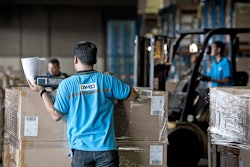
At the Centers for Disease Control and Prevention (CDC), there’s a weigh scale (a really big one) that the agency uses to help gauge the relative health of the country. Its latest conclusion: Americans are fat.
Collectively, the CDC reports that 70 percent of us are overweight, and 40 percent of us are obese.
So, what’s that got to do with logistics? Well, the freight industry is immersed in its own obesity epidemic. Instead of pounds, we need to shed truck miles.
Log in to view the full article
At the Centers for Disease Control and Prevention (CDC), there’s a weigh scale (a really big one) that the agency uses to help gauge the relative health of the country. Its latest conclusion: Americans are fat.
Collectively, the CDC reports that 70 percent of us are overweight, and 40 percent of us are obese.
So, what’s that got to do with logistics? Well, the freight industry is immersed in its own obesity epidemic. Instead of pounds, we need to shed truck miles.
Those extra miles place a crushing financial burden on private and commercial fleets. The costs are particularly onerous in the food industry, where razor thin margins simply aren’t capable of absorbing the cost of inefficient back-end operations.
Fat Has Financial Consequences
Fat, on a body or a business, has consequences.
Let’s talk food. As far back as 2001, the U.S. Surgeon General linked America’s “overweight and obesity epidemic” to a host of diseases. Some put the cost of obesity-linked healthcare as high as $315 billion annually.
Just as excess calories drive up healthcare costs, excess truck miles are the root cause of a host of supply chain cost drivers. More miles mean:
- Higher fuel costs
- Reduced truck life
- Increased equipment costs
- More drivers, inflating
- labor costs
- Higher maintenance costs
Thanks to the American Transportation Research Institute’s annual study, we know that each extra truck mile we drive is costing us $1.69.
Let’s look at some numbers. The Federal Highway Administration tells us that the average truck travels 68,000 miles a year. Using the American Trucking Association’s (ATA) estimate of 3.63 million Class 8 trucks in operation, that adds up to 246.8 billion truck miles driven per year.
In Paragon’s experience across hundreds of private fleet evaluations, poor truck routing practices can inflate truck fleet inefficiency by 10 percent to 30 percent. But assuming a 5 percent efficiency gain is possible across America’s fleets, we’re still talking about 12.3 billion avoidable miles and $20.9 billion in preventable costs.
Why is no one paying attention to this?
The Root of the Problem
To understand how we got into this mess, you first need to appreciate the daily whirlwind within which fleet managers operate.
Today, consumers want faster, more frequent deliveries made to tighter time windows and with more precise ETA data. As fleet managers struggle to address these customer service challenges, internal pressures mount to support larger order volumes at the same cost with the same resources. Somewhere between this rock and hard place, fleet managers must generate an optimized truck routing plan that makes everyone happy. But it’s just not possible—at least not without the aid of technology.
When you don’t give route- or load-planners the tools to balance service and cost factors, they will do whatever is needed to meet delivery requirements and avoid failure. As a result, trucks and drivers are added that aren’t really needed, draining company profits in the process.
Tech Helps Fight the Flab
Luckily, technology can help. In the same way that Fitbits and calorie-counting apps are helping people trim down, truck route optimization software can help keep excess truck miles to a minimum.
This software uses sophisticated algorithms to assess dozens of factors that could impact delivery time and distance, such as average road speeds, unloading time for each stop and meal breaks. It does this across hundreds of stops in a fleet’s daily delivery plan. Despite the millions of possible permutations, the software kicks out a highly accurate, multi-stop route plan within minutes, minimizing time and miles. To accomplish the same task in a manual planning environment would take multiple route planners hours, with far less accurate results.
In planning truck routes, we need to stop asking humans to do the work of a powerful computer.
Private delivery fleet operators, in particular, have been slow to adopt technology to improve fleet efficiency. Instead, they rely on rudimentary systems, even spreadsheets, to manage highly complex route planning. Fleet managers aren’t oblivious to the need to for routing efficiency. They want to cut the fat, but there’s no simple “bathroom mirror test” to suggest action is required. No equivalent to “ideal freight BMI” to serve as a point of comparison with current delivery performance. So, businesses stick with “the way we’ve always done it,” particularly when orders are being processed and deliveries are being made without glitches or customer complaints.
When it comes to truck fleets, inefficiency can hide in a way that a bulging waistline can’t. Even to the savviest business owners, route inefficiencies don’t stand out on a P&L. Identifying them requires some detective work.
Putting Your Fleet on a Truck Mile Diet
At most small to mid-sized distribution businesses, delivery route planning processes lack the sophistication to produce routes precisely planned down to the minute and the mile. What’s the upside of investing in leading-edge systems? Here’s an exercise you can do right now. Multiply your total miles by 10 percent and 30 percent, then multiply those figures by $1.69 to arrive at a range of savings.
These savings drop straight to the bottom line once routing software is paid for in 3-12 months.
According to the CDC, about 50 percent of Americans have been on a diet in the last year, supporting a $33 billion weight loss product industry—much of which centers around counting and controlling calories.
For fleet operators, the truck mile is as obvious an enemy as the calorie is to dieters. It’s the common denominator for a host of ills that are driving up your fleet operating costs and carbon footprint. We need to start counting truck miles like dieters count calories.
The ‘Freight-loss’ Challenge
Remember when the makers of Special K cereal asked us if we could “pinch an inch?” Fleet operators in the food industry, whether private or commercial, need to figure out just how many unwanted, unnecessary and expensive miles could be removed while meeting delivery requirements.
It’s time for a good, hard look in the mirror. The simple truth is that more miles equate to less profit. By going on a truck-mile diet with the aid of proven technology, food manufacturers and distributors can seize a golden opportunity to get a far more attractive bottom line.











